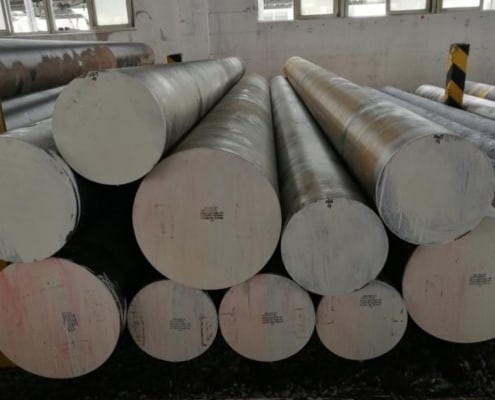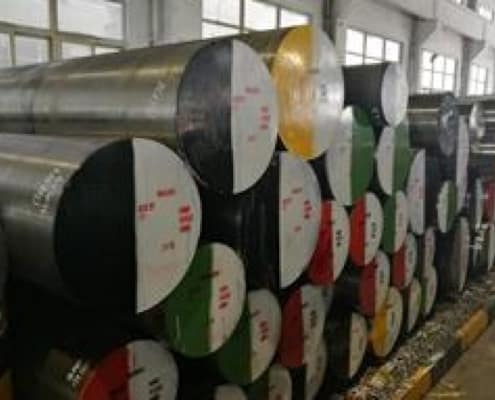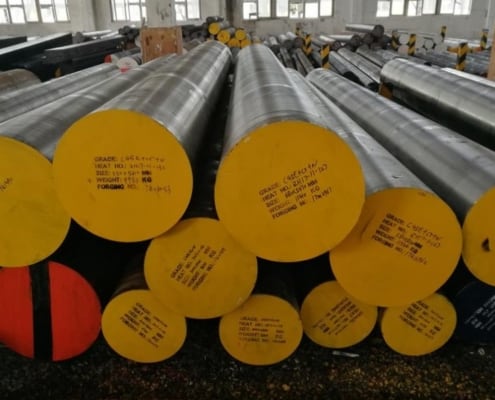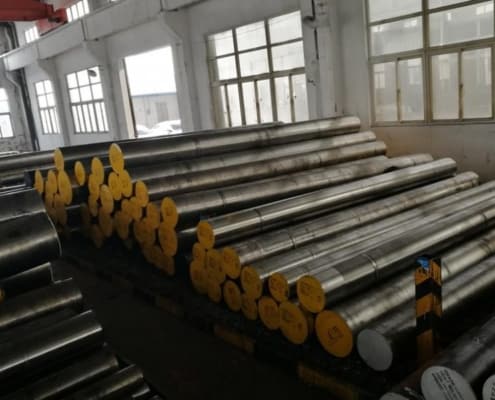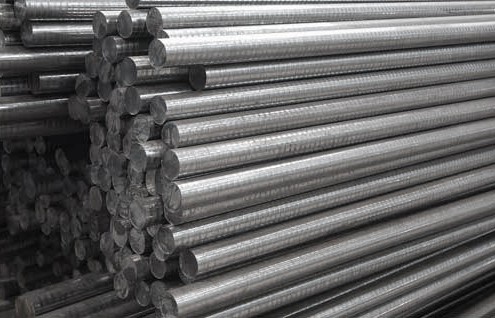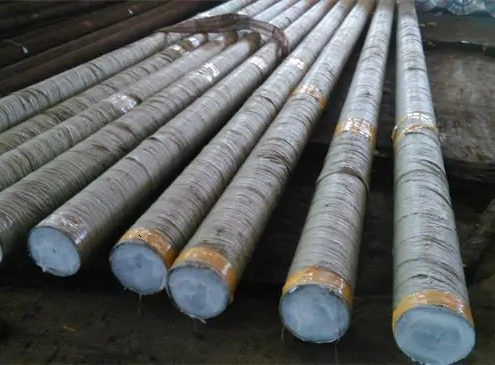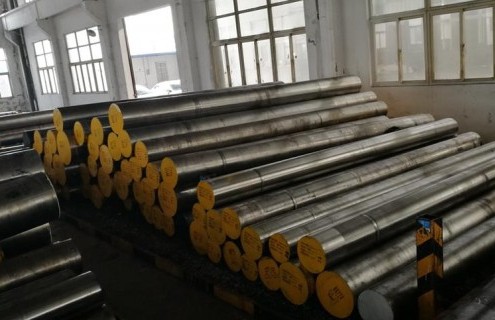What is ALLOY STEEL – THE COMPREHENSIVE FAQ GUIDE
Have you ever thought of using alloy steels for your projects? Are you not sure whether or not it is the type of steel that can help and assist you in getting rid of all the problems and troubles you have?
Don’t worry – alloy steel is not something that’s going to take a lot of your time! In fact, you’ll be able to understand what alloy steel is easily!
With this ultimate guide on alloy steel, you’ll know every substance present it in. On a more serious note, you’ll learn the ins and outs of alloy steel! You’ll find out the best applications of it, how you can use it to your advantage, and why it’s a recommended type of steel!
WHAT IS ALLOY STEEL?
If you’re into steels for quite some time now, then you would already know what alloy steels are.
Image of alloy steels getting prepared for distribution
For the benefit of everyone, including those who are beginners in the industry, alloy steel is formed when carbon steel is combined with any other alloying element.
These alloys can occupy amounts that range between 1% and 50%, and this is for the improvement and the development of the mechanical properties of the steel.
DOES ALLOY STEEL RUST?
Steels, no matter how resistant they are to corrosion, will eventually rust or oxidize, especially if you fail to care and maintain them properly.
Rusted or oxidized alloy steel
Since alloy steels is carbon steel with alloying elements, it is imperative to understand how rusting or how oxidation occurs – and it is only when the alloy steel contains iron.
However, even if alloy steel does not contain any type of iron, it can still tarnish, corrode, or oxidize as this is one of the many chemical reactions that steels and metals have.
ALLOY STEEL VS. CARBON STEEL
So how does carbon steel differ from alloy steel? What are the different traits and characteristics that they have?
Image of carbon steel flat bars
In the easiest and the most basic ways of distinguishing them, carbon steel is like the basic classification of steel. It’ll become alloy steel when you add alloying elements to it, and it can be any of the alloying elements available.
So, if you are now asking if carbon steel is pure iron and carbon, there are times that it is and there are times that it’s not. Akin to all the other types of steel, carbon steel will and may have impurities.
WHAT ARE THE DIFFERENT TYPES OF ALLOY STEEL?
Essentially, you can categorize alloy steels into two (2) different types: low alloy steels and high alloy steels.
Low alloy steels are alloy steels that have 8% or less alloying elements part of the content. Everything that goes above 8% is already considered as high alloy steel.
While you may think that high alloy steels are more common, it’s actually the other way around. Low alloy steels remain to be the most common types of alloy steels in the market today.
Some of the examples of the most common low alloy steels are: 41xx family steels, 13xx family steels, 61xx family steels, 256A, D6AC, 300M, 94Bxx family steels, and others.
The most common high alloy steels, on the other hand include stainless steel (12% chromium), high speed steels (HSS), and many more!
WHAT IS THE CHEMICAL COMPOSITION OF ALLOY STEEL?
Exact chemical compositions of alloy steels will depend on the type of steel it is. For instance, if it’s a 4130 type of alloy steel, it’ll be comprised of chromium-molybdenum, with about 0.30% carbon, small parts of silicon, vanadium, sulfur, and so on.
So, you would need to know the type of alloy steel you want to get the composition of – you can’t just look for what the chemical composition is.
Later in this FAQ guide, though, we will be giving you some of the most common alloying elements so that you know what contents are mixed to carbon steels, making them alloy steels.
PROPERTIES OF ALLOY STEEL
What characteristics do alloy steels have? What are the things that you can expect from using alloy steels? Ultimately, what traits are you thinking of when you chose alloy steel?
The following points are the different properties of alloy steel:
Hardenability
Just to clarify, hardenability and hardness are two (2) different things. Hardenability pertains to the depth a material can be in after it’s placed under a heat treatment process.
Hardness, on the other hand, is the measurement of a material’s resistance to indentation, warping, or scratching.
Strength
The strength of alloy steel is pertaining to the behavior of it when it’s placed under strains and stress. You can compare it to the strength of a person – place that thought in a steel and you get this particular property.
Moreover, it’s the alloy steel’s ability to withstand load without breaking, denting, being deformed, or being damaged.
Toughness
Toughness is the measure of a material – or alloy steels, in this manner – to absorb energy and deform without being fractured.
You can think of a tough material to be a material that is strong and ductile all at the same time.
Wear and Corrosion Resistance
Wear resistance is the alloy steel’s ability to resist damaging, deformation, and gradual removal of the contents or the substances on its surfaces.
Corrosion resistance refers to the alloy steel’s ability to protect itself from oxidation or from being succumbed to rust.
Hot Hardness
Last but definitely not the least out of the properties of alloy steel is hot hardness. Again, don’t be confused with what hot hardness is, as it’s simply the hardness of the material at highly elevated and escalated temperatures.
These are some of the things involved in alloy steels, so in case you were wondering what all the fuss is about, this is it!
When you decide to use and utilize alloy steel, you can expect these properties and characteristics!
IS ALLOY STEEL BETTER THAN STAINLESS STEEL?
We know that alloy steels are the steels that contain other alloying elements apart from iron and carbon.
But how is it in terms of quality compared to stainless steel?
Image of different forms of stainless steel
Therefore, it can be a combination of multiple elements jammed up with each other.
Stainless steel, on the other hand, is considered to be a low-carbon, high-alloy type of steel because it contains low levels of carbon but higher levels of chromium (about 10%).
Below are the differences of the two so you can decide which is better for you:
Tensile Strength
Tensile strength is the steel’s ability to resist breaking even if it’s placed under tension. The tensile strength of stainless steel, depending on the grade, sits between 515 and 827 MPa.
On the other end of the rope, alloy steels are at 758 to 1,882 Mpa. This makes alloy steels better in the area of tensile strength.
Thermal Conductivity
The thermal conductivity of a steel doesn’t necessarily have to be high – because thermal conductivity is the property of materials to conduct heat.
Stainless steel’s thermal conductivity is within the ranges 11.2 to 36.7 Watts per meter Kelvin (W/m-K), while the alloy steel is at 26 to 48.6 W/m-K.
Meaning, alloy steels are more conductive and are more capable of generating heat, which, again, can be good or bad depending on the situation.
Composition
As we all know, alloy steel is composed of iron, carbon, and other multiple alloying elements including chromium, boron, silicon, phosphorus, sulfur, vanadium, manganese, and many more.
Stainless steel is a type of high alloy steel, with abundant levels of nickel and chromium. That’s mainly the reason why it’s separated in the steel sector.
Now, we know that alloy steel has higher levels of tensile strength compared to stainless steels. In addition to that, alloy steels are also more thermally conductive than stainless steels.
However, the term “better” is relative and it will be depending on what applications you have with it.
WHAT ARE EXAMPLES OF ALLOY STEEL?
Since alloy steels are categorized and separated into two (2) groups (low alloy steels and high alloy steels), there are hundreds, if not thousands of alloy steels in the market.
8620 steel – one of the most sought-after alloy steels in the market
To give you the most customary alloy steel grade and examples, they include:
- 4140 Steel(Chromium-Molybdenum-Steel)
- 1020 Steel(Low-Carbon, Tensile Steel)
- 4340(Chromium-Molybdenum-Nickel Steel)
- 8620 Steel(Nickel-Chromium-Molybdenum-HSLA Steel)
IS ALLOY STEEL EXPENSIVE?
Again, this question is somewhat relative on how it’s asked. But, if we were to compare it with carbon steel and stainless steel, alloy steel can be placed in the higher-price category.
Carbon steel is quite possibly the cheapest as it only contains carbon. Stainless steel follows carbon steel because it contains low levels of carbon, but high in alloy such as chromium and nickel.
What makes alloy steel expensive is the supplement and the addition of alloying elements into its composition.
For instance, alloy steels can have multiple alloying elements such as vanadium, nickel, manganese, silicon, and other types of elements. Therefore, the procedure on how it’s made could be more difficult and more complex than what it really is.
Uses of Alloy Steel
Now, let’s get onto the most important part – where do you use alloy steels? What applications can you have with it?
Railroad industry – one of the most common applications of alloy steel
While many people think alloy steels have limited use, it’s actually not. The principal use of alloy steels are employed in the construction and the industrial sector.
Because of its complexity and its overall sophistication with the added alloying elements, you can find it useful in other industries and businesses, too, some of which include:
- Railroad Industry and/or Sector
- Electrical Industry
- Structural and/or Engineering Industry
- Pressure Vessel Industry
- Military and Defense Industry
- Energy Sector
- Welding and Manufacturing Industry
These aren’t everything – in fact, these are only some of the most common applications and industries where you can use alloy steels.
You can use it for any type of business or sector – so long that you require any of the properties that it has.
DIFFERENT ALLOYING ELEMENTS THAT CONTRIBUTE TO THE CREATION OF ALLOY STEEL
As mentioned many times above, alloy steels contain too few alloying elements. Here’s a quick list of some of the most common as well as their function or their role in an alloy steel:
| Element (Symbol) | Function or Use |
| Vanadium (V) | Increased hot hardness |
| Boron (B) | Improvement of hardenability |
| Bismuth (Bi) | Improvement of machinability |
| Nickel (Ni) | Increased toughness and corrosion resistance |
| Copper (Cu) | Improved corrosion resistance |
| Chromium (Cr) | Developed corrosion resistance and hardenability |
| Molybdenum (Mo) | Prevents grain growth |
| Silicon (Si) | Improves yield strength and hardenability. It also develops the magnetic properties of the alloy steel. |
CAN YOU BUY ALLOY STEEL WHOLESALE?
Yes, in fact, we here at Waldun Steel can give you the best and the most competitive rates if you purchase alloy steels wholesale!
Unlike other companies, we do not have an MoQ – you can buy and purchase depending on the needs your company or your business has!
THE BEST ALLOY STEEL MANUFACTURER IN CHINA
Across the entire country, we at Waldun Steel are the company that’s considered to be the best and the most trusted in supplying alloy steels.
Whatever industry you might be in, and in whatever application you’ll use alloy steels for, you can absolutely bank and count on us!
Just like hundreds to thousands of other businesses and companies worldwide, you too can experience world-class quality alloy steels in the best rates and prices. Never worry or think about where to find the best and the highest qualities of alloy steels ever again!
WALDUN – Reliable Quality Alloy Steel Manufacturer
WALDUN is a key alloy supplier & manufacturer in China. WALDUN provides fast and reliable delivery, with easy access for companies throughout the world.
Alloy steel referring to low alloy steel is contained with a variety of elements which are added strictly in addition to the carbon.
Typical alloyed elements are Molybdenum, Manganese, Nickel, Silicon, Aluminium, Chromium, and Vanadium.
Alloy steels are used to improve its mechanical or physical properties,such as wear resistance,strength, hardenability,corrosion resistance,ductility, formability, weldability and so on.Alloy steel is widely used in oil and gas,aerospace,automotive, wind power and defense industries etc.
General Production Size
| Form of Supply | Size(mm) | Length(mm) |
| Round bar | Φ6-Φ1,000 | 3,000-10,000 |
| Square bar | 100×100-600×600 | 3,000-6,000 |
| Plate/Sheet | Thickness :20-400 Width:80-1,000 | 2,000-6,000 |
| Flat bar/Blcoks | Thickness :120-800 Width:120-1,500 | 2,000-6,000 |
National Specification
1.ASTM A29/A29M:Standard Specification for General Requirements for Steel Bars, Carbon and Alloy, Hot-Wrought 2.EN10083-3:Steels for quenching and tempering,Part 3:Technical delivery conditions for alloy steels
3.EN10084:case hardening steels -Technical delivery conditions
4.EN10250-3:Open die steel forgings for general engineering purposes-Part 3:Alloy special steels
5.BS970-3:Wrought steel for mechanical and allied engineering purposes-Part 3:Bright bars for general engineering purposes
6.JIS G4105:Chromium Molybdenum Steels
7.JIS G4103:Nickel Chromium Molybdenum Steels
Alloy Steel Grade List
| AISI / SAE | DIN / EN | BS | JIS / KS |
| A182 Grade F11 | 13CrMo44/1.7335 | ||
| A182 Grade F22 | 10CrMo9-10/1.7380 | ||
| 16CrMo44/1.7337 | SCM415 | ||
| 4130 | 25CrMo4/1.7218 | 708A25 / 708M25 | SCM430 |
| 4135 | 34CrMo4/1.7220 | – | SCM435 |
| 4140 | 42CrMo4/1.7225 | 708M40 / EN19 | SCM440 |
| 4150 | 50CrMo4/1.7228 | – | SCM445 |
| 4340 | 34CrNiMo6/1.6582 | 817M40 /EN24 | SNCM439 |
| 5140 | 41Cr4/1.7035 | 530M40 | SCr440 |
| 8620 | 20NiCrMo2-2/1.6523 | 805M20 | SNCM220 |
| 9840 | 36CrNiMo4/1.6511 | 817A37 / 817M37 | – |
| – | 41CrAlMo7/1.8509 | EN41B | SACM645 |
Page Contents
- WHAT IS ALLOY STEEL?
- DOES ALLOY STEEL RUST?
- ALLOY STEEL VS. CARBON STEEL
- WHAT ARE THE DIFFERENT TYPES OF ALLOY STEEL?
- WHAT IS THE CHEMICAL COMPOSITION OF ALLOY STEEL?
- PROPERTIES OF ALLOY STEEL
- IS ALLOY STEEL BETTER THAN STAINLESS STEEL?
- WHAT ARE EXAMPLES OF ALLOY STEEL?
- IS ALLOY STEEL EXPENSIVE?
- DIFFERENT ALLOYING ELEMENTS THAT CONTRIBUTE TO THE CREATION OF ALLOY STEEL
- CAN YOU BUY ALLOY STEEL WHOLESALE?
- THE BEST ALLOY STEEL MANUFACTURER IN CHINA
- WALDUN – Reliable Quality Alloy Steel Manufacturer
- General Production Size
- National Specification
- Alloy Steel Grade List







